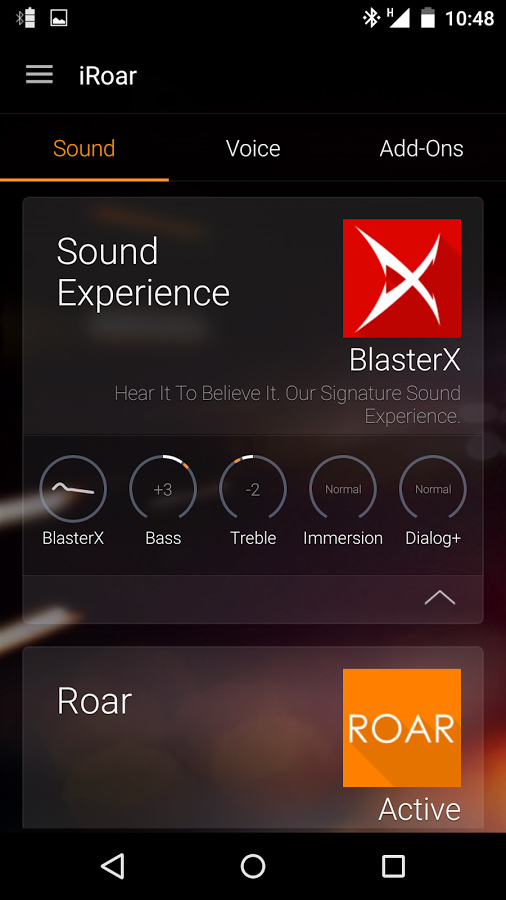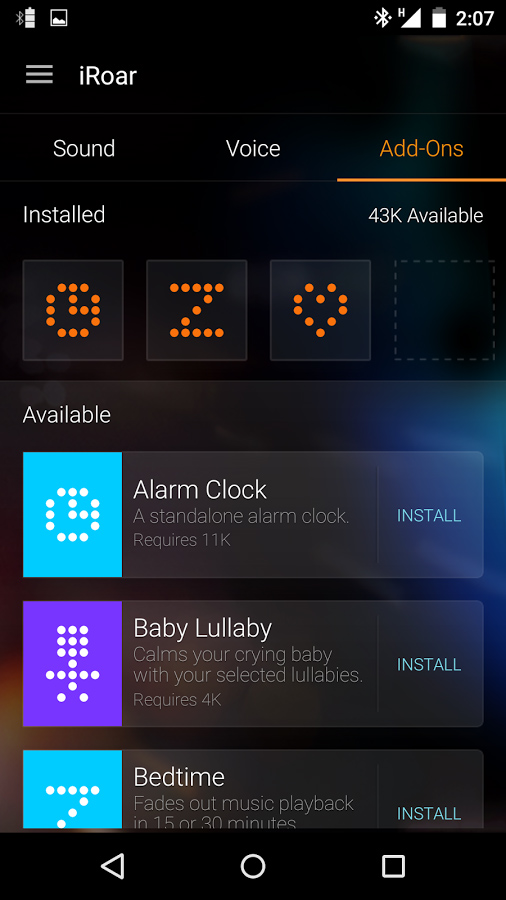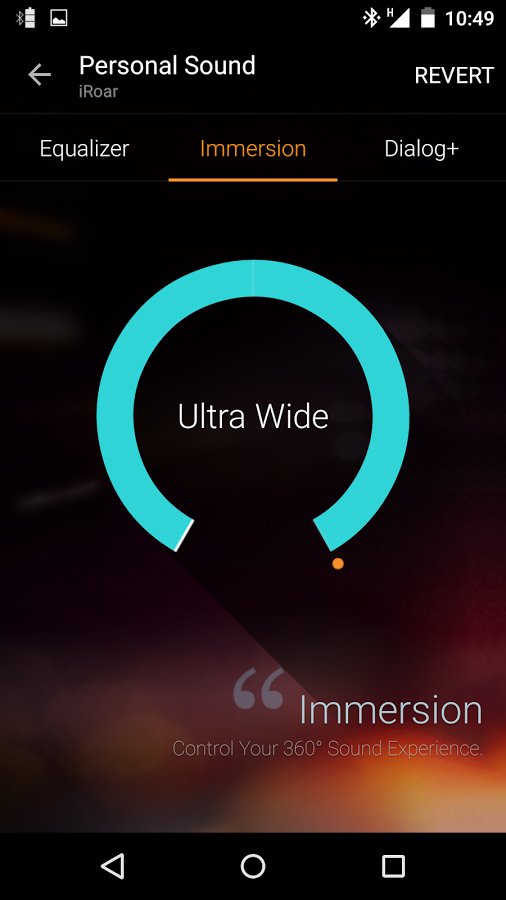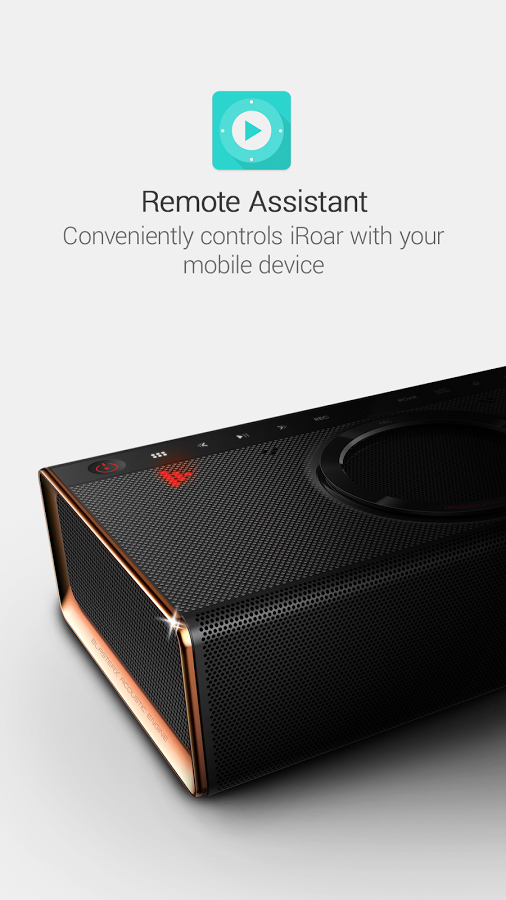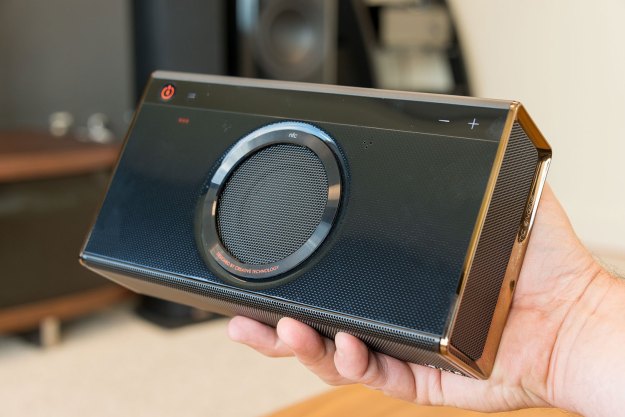
- Excellent sound quality
- Loaded with connectivity options
- Great design with touch controls
- Good battery life
- Software and hardware add-ons
- Expensive, especially with Rock subwoofer
- Not weather resistant
On the whole, Bluetooth speakers are getting better, with improved audio quality increasingly coming from smaller form factors. Creative has taken that approach in its Roar line of speakers in the past, with both the Sound Blaster Roar and Roar 2 pumping out impressive sound that was louder than one might expect.
Shedding the Sound Blaster moniker, the iRoar stands apart from its predecessors, ramping up its audio prowess and cramming in a Pandora’s Box of features that seem almost implausible for something this size. The excellent (and really loud) sound it pumps out is one thing, but the extras involved here take it to another level.
Out of the box
The box and packaging inside sticks closely to that of previous Roar speakers. The iRoar itself is nestled into its own section, with a flap that opens to reveal the accessories. These include the AC power adapter, micro-USB cable (in red, which is cool), a soft pouch to fit the speaker, and power plugs for North America, Europe, and the U.K.
Beyond that, there’s an instruction booklet outlining the various connectivity options (a full manual is available online) and a warranty paper to detail how that works.
Features and design
To add more audio prowess to the iRoar, Creative had to add some heft to it as well. It’s the same weight as the original Roar, albeit with a little more girth. Under the hood, the iRoar has two amps to better support high-loudness playback without sacrificing clean sound.
The speaker indents punctuating both sides fall very much in line with previous models, maintaining some consistency in the overall look and performance of the speaker. Grilles cover the front and sides, with a circular grill carved in to the top that includes an NFC tag for faster pairing with compatible devices. The black body with copper trim gives the iRoar a certain elegance, like a jewelry box with a glossy top.
The back holds all the inputs and controls. From left to right are the power adapter input, micro-USB input, micro-SD card slot with a loop or shuffle toggle, Aux-In jack, optical digital input and a regular 1.5A USB port for charging smartphones and tablets. On the bottom are two strips of rubber that provide good grip on just about any surface, along with connector dots for mounting on the Rock subwoofer dock.
The top offers backlit touch-sensitive controls for volume, calls, playback, track skipping, Roar, Mic Beam and a menu button. Below the menu button is another visual LED that indicates what source is connected and shows battery level when charging. Checking the battery during operation only requires holding the menu button until it appears below.
There is a modular element central to the iRoar’s laundry list of features.
The Roar button works exactly like that of previous models, where toggling it on gives the speaker an audio boost for more impact. Mic Beam is for 360-degree omnidirectional recording, though it needs a micro-SD card to store the recorded files.
Bluetooth pairing is simple enough. For NFC-enabled devices, a simple tap on the tag will do the trick, whereas going the old-fashioned route with those that aren’t, including iOS devices, is straightforward as well. Up to two devices can be connected at once, allowing for playback to start with one device, and carry on with another, if need be. While not a necessity in most situations, we can appreciate the selflessness in allowing more than one person to DJ a gathering amongst friends.
Setup
The basic setup doesn’t take much, but there is a modular element central to the iRoar’s laundry list of features. First, the speaker can be tinkered with using free apps on iOS and Android. The primary app is the iRoar Dashboard, which can change various settings and audio profiles on the fly, shifting sound output based on preset modes. It also offers a walkthrough guide and is the conduit to push firmware updates to the speaker.
Six sound profiles are baked in: BlasterX, Game On, Audiophile Bliss, Cinemania, Sonic Bass and Live Concert. An extra slot is available for a custom preset using the built-in EQ. Immersion and Dialog+ settings adjust how sounds and vocals come through. There’s a Roar button on the app for quick toggling, plus Smart Volume, an interesting feature that hones in on the audio to adjust volume on the fly for better clarity. The Night Mode keeps things sounding full at low volumes levels for late night listening.
As if that wasn’t enough, there’s more. Add-ons can be downloaded to the micro-SD card and installed as extra features for the speaker; examples include an alarm clock, a shake-to-listen feature (using the iRoar’s built-in accelerometer) and even nature sounds. Once installed, these become accessible via the touch controls at the top. Creative has an open SDK (software developer kit) for the iRoar to draw in more apps and features from developers.
The second app is the iRoar Remote Assistant for controlling playback for music stored on the device and accessing any audio stored on a micro-SD card slotted into the back. The app did nothing when we were using a streaming music or podcast app, making its overall usefulness questionable.
The inputs on the rear panel enable a variety of setup options. The optical input make it easy to use the iRoar with a TV or PC, and Cinemania and Game On presets are there to optimize it for watching movies, shows, or playing video games. We also tried this setup with a regular Aux-In cable with some success, though the optical connection offered a cleaner signal. Having the micro-USB port in the back enables the iRoar to work seamlessly as a wired computer speaker, too.
Two iRoars can also be paired together using Creative’s $10 red-and-white MegaStereo cable that configures one speaker acting as the master and the other as the slave. Doing this creates left and right channel speakers for more dynamic performance. As we didn’t have two Roars to try this out, we can’t attest to how worthwhile it may be. In our experience with other speakers, stereo separation is the real benefit, with no real addition of bass or loudness – stuff the iRoar doesn’t suffer from a lack of anyway.
Two accessories also stand out for their compatibility. The more interesting is the iRoar Rock subwoofer dock that pushes everything to 11, and blew us away in how it enhanced the existing goodness of the iRoar, while also filling in the bass gaps that a small Bluetooth speaker simply can’t manage on its own.
The second accessory is the iRoar Mic, a wireless microphone that turns the speaker into a public address system, complete with adjustable features like voice morphing (fun? Yes. Practical? No.)
Audio performance
In spite of its size, the iRoar is a beast, earning its moniker in spades. Not only is it louder than its predecessors, it sounds cleaner and more balanced to boot. And this is without using the Roar button often to get a volume boost.
The most obvious difference is the lack of distortion on the low end, giving bass the chance to breathe and complementing the already solid highs and mids. Sade’s No Ordinary Love sounded both mesmerizing and haunting, with the bass guitar sounding great next to her superb voice. Prince’s Do Me, Baby sounded warm and natural, and we felt the same with the nuances of Maxwell’s Fingers Crossed.
Not only is it louder than its predecessors, it sounds cleaner and more balanced
Whether it was hip hop, smooth jazz or classic rock, the iRoar didn’t seem to care. By not teetering from one end of the spectrum to the other, it maintained a balance that didn’t sacrifice one genre over another. The way instruments resonated, especially at higher volumes, was a testament to how Creative managed to go beyond just being loud with the iRoar.
The preset profiles in the Dashboard app figured into this as well for us. Creative’s signature BlasterX profile is good, though we had a lot of fun playing with the others. For example, Audiophile Bliss flattens much of the spectrum, dialing back the bass, but not too much. Live Concert we only used for live recordings and came away liking the extra attention given to the lows. Sonic Bass is exactly as it sounds, and a go-to for hip hop and electronica tracks. Turning on the Roar setting and adding the Rock to that equation served to bring the iRoar’s bass output into a different category altogether.
We also truly enjoyed using the iRoar with a TV, and consistently toggled between the Game On and Cinemania profiles, the latter of which we put to great use during both the UEFA Euro 2016 and Copa America Centenario soccer tournaments. Movies and shows also sounded great, while games got a nice boost over the terrible built-in TV speakers in our TV. While it’s certainly debatable whether the iRoar could really replace a soundbar, we felt we could get away with it, so long as the Rock was in the mix, too.
For the Rock to function, it needs a constant power connection, whereas the iRoar can stand on its own with the built-in battery. Creative rated it at 20 hours, but that was never going to happen once we kept raising the volume. As such, we usually ended up with a range between 10-15 hours, depending on how loud we were going. At lower volumes, we came much closer to the 20-hour mark.
As an aside, we should note that it is possible to record music playing on the speaker directly to an inserted micro-SD card, but as was the case with the previous Roar speakers, the low 64kbps bitrate makes it pointless to do for anything outside of voice calls.
Warranty information
Creative offers a one-year limited warranty upon proof of purchase, and is only applicable in the country or territory where the iRoar was purchased. It covers parts and labor for any defects on the device, but not accidental damage caused by the user.
Conclusion
The iRoar is probably the best portable speaker the company has produced to date, and certainly one of the best we’ve tested overall. Its audio performance rivals that of speakers costing twice, the cleaner sound at louder volumes is easy to appreciate, and the litany of features that can enhance or expand on the iRoar’s functionality close the deal.
You owe it to yourself to hear this speaker. It’s incredible.
It doesn’t have the weather-proofing of other speakers in its category, but it outclasses many Bluetooth speakers with the sheer depth of what it produces and offers. Its namesake is appropriate, not just for how loud it can get, but also for the verve and gusto with which the iRoar delivers.
It’s pricey at $370, and adding another $150 for the Rock or $80 for the Mic makes the full suite an expensive proposition. The add-ons are only necessary if you need them, but the Rock does give the iRoar a boost that pushes it beyond the bounds of any other Bluetooth speaker we’ve tested. Giving the iRoar an Editor’s Choice award was a no-brainer.
Editors' Recommendations
- Best wireless speakers for 2024: Sonos, JBL, KEF, and more
- IP what? Explaining water and dust resistance for audio gear
- B&O’s latest speaker is a love letter to aluminum
- Sonos Move 2: Sonos’ biggest portable speaker gets a big update
- UE’s Epicboom is a powerful, portable, pool-proof speaker







